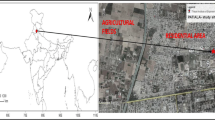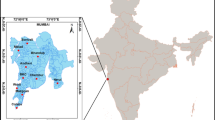Abstract
Emission source characterization and meteorological influence are the key aspects to gain insight into the ground ozone governing mechanisms. Receptor-based data analysis techniques help in comprehending local ozone fluctuations in the lack of accurate information on the emission characteristics. Through sophisticated data analysis, the current study offers insight into the key factors influencing the ozone changes in the vicinity of power plants. Ground ozone (O3) and its precursor variables carbon monoxide (CO), nitric oxide (NO), nitrogen dioxide (NO2), Sulphur dioxide (SO2), benzene, toluene, ethyl-benzene and xylene (BTEX) along with the particulate matter of size less than 10 and 2.5 micron (PM10 and PM2.5) and meteorological variables have been studied at a residential site near the coal-fired power plant in the two cities; Chandrapur and Nagpur during 2016–2019. O3 is observed to be not correlated significantly (r<0.16 and <0.1 in Nagpur and Chandrapur, respectively) with any of its precursor variables in two cities. On a finer time scale, however, an association of O3 with CO, NO, NO2 and BTEX suggested that the O3 formation mechanism is driven by volatile organic compounds (VOCs) (mainly BTEX), CO and NOx. On the coarser scale, however, seasonality and other factors have distorted the correlation. Random forest model with O3 concentration as the response variable and NO2, NO, SO2, CO, BTEX, PM10 and PM2.5 as independent variables suggested that PM10, NO, CO and solar radiation are highly important variables governing the O3 dynamics in Chandrapur. In Nagpur, wind direction, relative humidity, temperature, toluene and NO2 are more important. Qualitative analysis to assess the contribution of emission sources suggested the influence of traffic emissions in Nagpur and the dominance of non-traffic related emissions, mainly power plant and mining activities in Chandrapur. The hazard quotient is observed to be >1 in both cities suggesting a health hazard to the residents living in the area.







Similar content being viewed by others
Data availability
Not applicable.
References
Chakraborty, N., Mukherjee, I., Santra, A.K., et al. 2008. Measurement of CO2, CO, SO2, and NO emissions from coal-based thermal power plants in India. Atmospheric Environment 42: 1073–1082.
Garcia, J.P., Beyne-Masclet, S., and Mouvier, G. 1992. Emissions of volatile organic compounds by coal-fired power stations. Atmospheric Environment 26 (9): 1589–1597.
Garg, A., Kapse, M., Shukla, P.R., et al. 2002. Large Point Source (LPS) emissions from India: Regional and sect oral analysis. Atmospheric Environment 36: 213–224.
Guttikunda, S.K., and Jawahar, P. 2014. Atmospheric emissions and pollution from the coal-fired thermal power plants in India. Atmospheric Environment 92: 449–460.
Mittal, M.L., Sharma, C., Singh, R., 2006. Estimates of Emissions from Coal Fired Thermal Power Plants in India. Available at: https://www3.epa.gov/ttnchie1/conference/ei20/session5/mmittal.pdf. Accessed 1 Mar 2023.
Visuvasam, D. Selvaraj, P. Sekar, S., 2005. Influence of Coal Properties on Particulate emission control in Thermal Power Plants in India. Proceedings in Second International Conference on Clean Coal Technologies for our Future (CCT 2005), Sardinia, Italy.
Prasad, A., Singh, R., and Kafatos, M. 2012. Influence of coal-based thermal power plants on the spatial–temporal variability of tropospheric NO2 column over India. Environmental Monitoring and Assessment 184: 1891–1907.
Sun, L., Webster, M., McGaughey, G., et al. 2012. Flexible NOx abatement from power plants in the Eastern United States. Environment Science Technology Columbus 46: 5607.
Varma, S.A., Srimurali, M., and Varma, M. 2013. Ozone pollution in India due to power plant emissions. International Journal of Scientific Research 2: 12–13.
Olaniyan, T., Jeebhay, M., Roosli, M., et al. 2017. A prospective cohort study on ambient air pollution and respiratory morbidities including childhood asthma in adolescents from the Western Cape Province: Study protocol. BMC Public Health 17 (712): 1–13.
Pope, C.A., and Dockery, D.W. 2006. Health effects of fine particulate air pollution: Lines that connect. Journal of the Air and Waste Management Association 56: 709–742.
Pope, C.A., Lefler, J.S., Ezzati, M., et al. 2019. Mortality risk and fine particulate air pollution in a large, representative cohort of US adults. Environmental Health Perspectives 127 (7): 077007.
Liu, X., Lessner, L., and Carpenter, D.O. 2012. Association between residential proximity to fuel-fired power plants and hospitalization rate for respiratory diseases. Environmental Health Perspectives 120 (6): 807–810.
Olufemi, A.C., Mji, A., and Mukhola, M.S. 2019. Health risks of exposure to air pollutants among students in schools in the vicinities of coal mines. Energy Exploration & Exploitation 37 (6): 1638–1656.
Wright, C.Y., Oosthuizen, R., John, J., et al. 2011. Air quality and human health among a low income community in the Highveld priority area. Clean Air Journal 20 (1): 12–20.
Alberini, A., Cropper, M., Simon, N.B. et al. 1997. The health effects of air pollution in Delhi, India. Policy Research Working Papers. The World Bank: Washington, DC.
Chhabra, S.K., Chabra, P., Rajpal, S., et al. 2001. Ambient air pollution and chronic respiratory morbidity in Delhi. Archives of Environmental Health 56 (1): 58–64.
Cohen, A.J., Anderson, H.R., Ostra, B., et al. 2005. The global burden of disease due to outdoor air pollution. Journal of Toxicology and Environmental Health. Part A 68: 1–7.
Kenessary, D., Kenessary, A., Adilgireiuly, Z., et al. 2019. Air pollution in Kazakhstan and its health risk assessment. Annals Global Health 85 (1): 133.
Salam, M.T., Millstein, J., Li, Y., et al. 2005. Birth outcomes and prenatal exposure to ozone, carbonmonoxide, and particulate matter: results from the children’s health study. Environmental Health Perspectives 113: 1638–1644.
Wang, Y., Wild, O., Chen, H., et al. 2020. Acute and chronic health impacts of PM2.5 in China and the influence of inter-annual meteorological variability. Atmospheric Environment 229: 117397.
Andersen, Z.J., Kristiansen, L.C., and Andersen, K.K. 2012. Stroke and long-term exposure to outdoor air pollution from nitrogen dioxide: A cohort study. Stroke 43: 320–325.
Chauhan, S.K., Saini, N., and Yadav, V.B. 2014. Recent trends of volatile organic compounds in ambient air and its health impacts: A review. International Journal for Technological Research in Engineering 1: 667–678.
Esteve-Turrillas, F.A., Pastor, A., and de la Guardia, M. 2007. Assessing air quality inside vehicles and at filling stations by monitoring benzene, toluene, ethylbenzene and xylenes with the use of semipermeable devices. Analytica Chimica Acta 593: 108–116.
Ras, M.R., Marcé, R.M., and Borrull, F. 2009. Characterization of ozone precursor volatile organic compounds in urban atmospheres and around the petrochemical industry in the Tarragona region. Science of the Total Environment 407: 4312–4319.
ATSDR. 2005. Toxicological Profile for Benzene. Agency for Toxic Substances and Disease Registry (ATSDR): Atlanta, GA, USA. Available online at: https://www.atsdr.cdc.gov/toxprofiles/tp3.pdf. Accessed 1 Mar 2023.
ATSDR. 2005. Toxicological Profile for Ethylbenzene. Agency for Toxic Substances and Disease Registry (ATSDR): Atlanta, GA, USA. Available online at: https://www.atsdr.cdc.gov/ToxProfiles/tp110.pdf. Accessed 1 Mar 2023.
ATSDR. 2005. Toxicological Review of Toluene. In support of Summary Information Integrated Risk Information System (IRIS); EPA/635/R-05/004; United States Environmental Protection Agency (US EPA): Washington, DC, USA. Available online at: https://cfpub.epa.gov/ncea/iris/iris_documents/documents/toxreviews/0118tr.pdf. Accessed 1 Mar 2023.
ATSDR. 2005.Toxicological Review of Xylene. In support of Summary Information Integrated Risk Information System (IRIS); EPA/635/R-03/001; United States Environmental Protection Agency (US EPA): Washington, DC, USA. Available online at: https://cfpub.epa.gov/ncea/iris/iris_documents/documents/toxreviews/0270tr.pdf. Accessed 1 Mar 2023.
Moolla, R.J., Curtis, C.J., and Knight, J. 2015. Occupational exposure of diesel station workers to BTEX compounds at a bus depot. International Journal of Environmental Research and Public Health 12: 4101–4115.
Sekar, A., George, K.V., and Ravi Varma, M.K. 2019. Analysis of benzene air quality standards, monitoring methods and concentrations in indoor and outdoor environment. Heliyon 5: e02918.
Indian Council of Medical Research, Public Health Foundation of India, and Institute for Health Metrics and Evaluation. India, 2017. Health of the Nation’s States—The India State-Level Disease Burden Initiative. New Delhi, India: ICMR, PHFI, and IHME.
USEPA. 2008. Air quality modeling platform for the ozone national ambient air quality standard final rule regulatory impact assessment.
Jiang, T.T., Chen, B., Nie, Z., et al. 2020. Estimation of hourly full-coverage PM2.5 concentrations at 1-km resolution in China using a two-stage random forest model. Atmospheric Research 248: 105146. https://doi.org/10.1016/j.atmosres.2020.105146.
Kaminska, J.A. 2018. The use of random forests in modelling short-term air pollution effects based on traffic and meteorological conditions: A case study in Wrocław. Journal of Environment Management 217: 164–174.
Stafoggia, M., Johansson, C., Glantz, P., et al. 2020. A random forest approach to estimate daily particulate matter, nitrogen dioxide, and ozone at fine spatial resolution in Sweden. Atmosphere 11: 239.
CPCB. Central Control Room for Air Quality Management - All India. 2020. Available at: https://app.cpcbccr.com/ccr/#/caaqm-dashboard-all/caaqm-landing. Accessed 20 Apr 2020.
USEPA. 2010. Quantitative health risk assessment for Particulate Matter. EPA-452/R-10-005.
Morakinyo, O.M., Adebowale, A.S., Mokgobu, M.I., et al. 2017. Health risk of inhalation exposure to sub-10 µm particulate matter and gaseous pollutants in an urban-industrial area in South Africa: an ecological study. British Medical Journal Open 7: e013941.
Patra, A., Gautam, S., and Kumar, P. 2016. Emissions and human health impact of particulate matter from surface mining operation—A review. Environmental Technology and Innovation 5: 233–249. https://doi.org/10.1016/j.eti.2016.04.002.
New York State Department of Health. 2023. Available at: https://www.health.ny.gov/environmental/indoors/air/pmq_a.htm. Accessed 1 Mar 2023.
Tiwari, V., Hanai, Y., and Masunaga, S. 2010. Ambient levels of volatile organic compounds in the vicinity of petrochemical industrial area of Yokohama. Japan Air Quality Atmosphere Health 2010 (3): 65–75.
Bretón, J.G.C., Bretón, R.M.C., Morales, S.M., et al. 2020. Health risk assessment of the levels of BTEX in ambient air of one urban site located in Leon, Guanajuato Mexico during two climatic seasons. Atmosphere 11: 165.
Garg, A., and Gupta, N.C. 2019. A comprehensive study on spatio-temporal distribution, health risk assessment and ozone formation potential of BTEX emissions in ambient air of Delhi, India. Science of The Total Environment 659: 1090–1099.
Lee, S.C., Chiu, M.Y., Ho, K.F., et al. 2002. Volatile organic compounds (VOCs) in urban atmosphere of Hong Kong. Chemosphere 48 (3): 375–382.
Sicard, P., Paoletti, E., Agathokleous, E., et al. 2020. Ozone weekend effect in cities: Deep insights for urban air pollution control. Environmental Research 191: 110193.
Brancher, M. 2021. Increased ozone pollution alongside reduced nitrogen dioxide concentrations during Vienna’s first COVID-19 lockdown: Significance for air quality management. Environmental Pollution 284: 117153.
Van den Berg, R. 1995. Human exposure to soil contamination: a qualitative and quantitative analysis towards proposals for human toxicological intervention values. RIVM Report No. 725201011. Bilthoven, The Netherlands: National Institute of Public Health and Environmental Protection (RIVM).
CPCB. 2009. National Ambient Air Quality Standards. Central Pollution Control Board, New Delhi. 18th November 2009. Notification in the Gazette of India, No.B-29016/20/90/PCI-L.
Maji, K.J., Dikshit, A.K., and Deshpande, A. 2016. Human health risk assessment due to air pollution in ten urban cities in Maharashtra. India Cogent Environmental Science 2: 1–16.
Acknowledgements
The authors are thankful to the Karunya Institute of Technology and Sciences, for their guidance and unstinted support for this study. Thanks are due to anonymous reviewers who provided constructive comments to improve the quality of the manuscript. The article has an approval from CSIR-NEERI with a KRC number of CSIR-NEERI/KRC/2023/MARCH/APC/3 dated 16/03/2023.
Funding
None.
Author information
Authors and Affiliations
Corresponding author
Ethics declarations
Conflict of interest
The authors declare that they have no competing interests.
Ethical approval
Not applicable.
Consent to participate
Not applicable.
Consent to publish
Not applicable.
Additional information
Publisher's Note
Springer Nature remains neutral with regard to jurisdictional claims in published maps and institutional affiliations.
Rights and permissions
Springer Nature or its licensor (e.g. a society or other partner) holds exclusive rights to this article under a publishing agreement with the author(s) or other rightsholder(s); author self-archiving of the accepted manuscript version of this article is solely governed by the terms of such publishing agreement and applicable law.
About this article
Cite this article
Chelani, A.B., Vyawahare, R. & Gautam, S. Study of ground ozone and precursors along with particulate matter at residential sites in the vicinity of power plant. Waste Dispos. Sustain. Energy 5, 535–549 (2023). https://doi.org/10.1007/s42768-023-00163-1
Received:
Revised:
Accepted:
Published:
Issue Date:
DOI: https://doi.org/10.1007/s42768-023-00163-1




